HERE COMES THE SUN
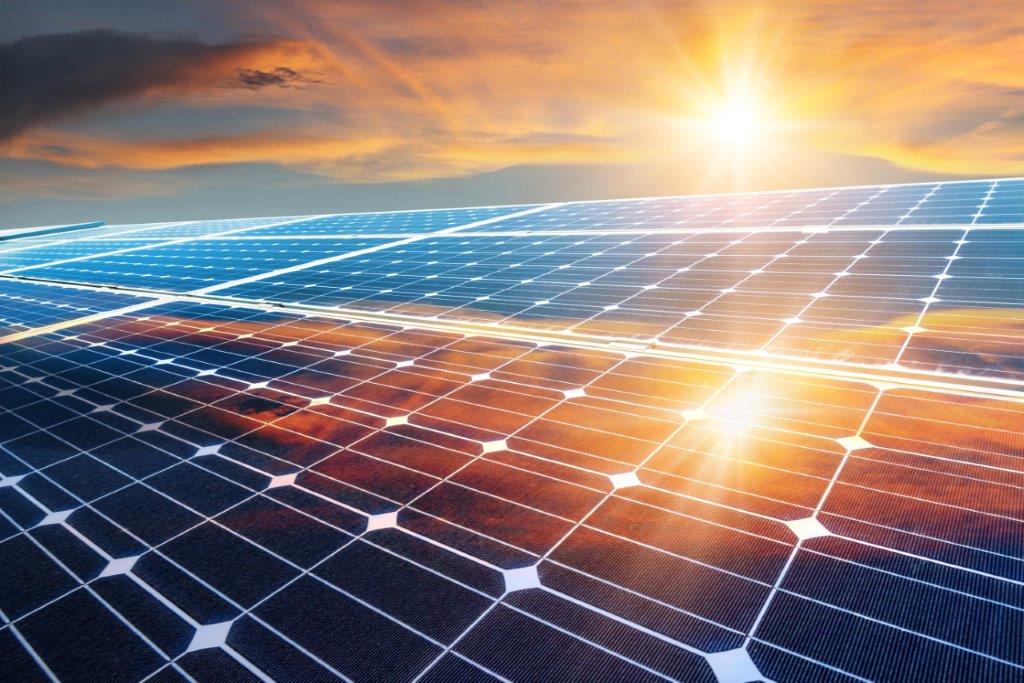
Reji Varghese explores how companies are using Laser Technology to harvest the power of the Sun…
The term ‘photovoltaic’ comes from the Greek word ‘phos’, meaning ‘light’, and from ‘volt’, the unit of electromotive force, the volt. Voltaic is also a word that relates to electricity produced by chemical reactions in a battery.
The ‘photovoltaic effect’ is a phenomenon that converts light to electricity using semiconducting materials. The photovoltaic effect is commercially used for electricity generation and as photosensors.
Some materials exhibit a property known as the photoelectric effect that causes them to absorb photons of light and release electrons. When these free electrons are captured, an electric current results that can be used as electricity.
The evolution of photovoltaics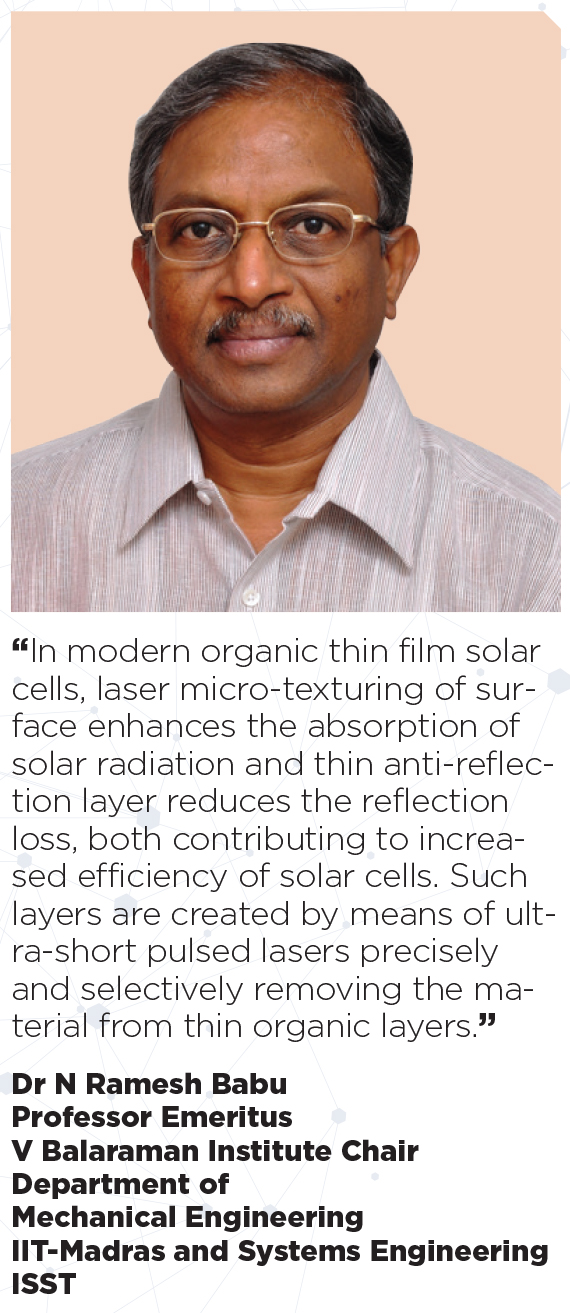
The photoelectric effect was first studied by French physicist Edmund Bequerel in 1839, who found that certain materials would produce small amounts of electric current when exposed to light. In 1905, Albert Einstein’s Nobel Prize-winning research described the nature of light and the photoelectric effect on which Photovoltaic technology is based. But it wasn’t until 1954 when the first photovoltaic module was built by Bell Laboratories as a ‘solar battery’, but it was far too expensive to gain widespread use commercially.
In the 1960s, the Space industry began to make the first serious use of the technology to provide power aboard spacecraft. Through the space programs, the technology advanced, its reliability was established, and the cost began to decline.
During the energy crisis in the 1970s, photovoltaic technology gained recognition as a source of power for non-space applications. A photovoltaic system generally employs multiple solar modules, each comprising a number of solar cells, which generate electrical power. They are generally made from semiconductors like silicon and are also referred to as ‘photovoltaic cells’ which means ‘producing a voltage when exposed to radiant energy such as light’.
Governments and companies around the world are investing in Photovoltaic technology in a big way to mitigate the negative effects of climate change. Solar PV has specific advantages as an energy source. Once installed, its operation does not generate any pollution or any greenhouse gas emissions.
Dr N Ramesh Babu, Professor Emeritus, V Balaraman Institute Chair, Department of Mechanical Engineering, IIT-Madras, says, “With the reduction in costs of PV modules and the increased efficiency of solar cells, photovoltaic systems are now becoming price competitive with fossil fuels.”
The technology also shows scalability with respect to power needs, and silicon has large availability in the earth’s crust. Solar power has experienced the highest growth rates of all renewable energies in recent years, and its potential in the future is immense.
Commercial production of photovoltaics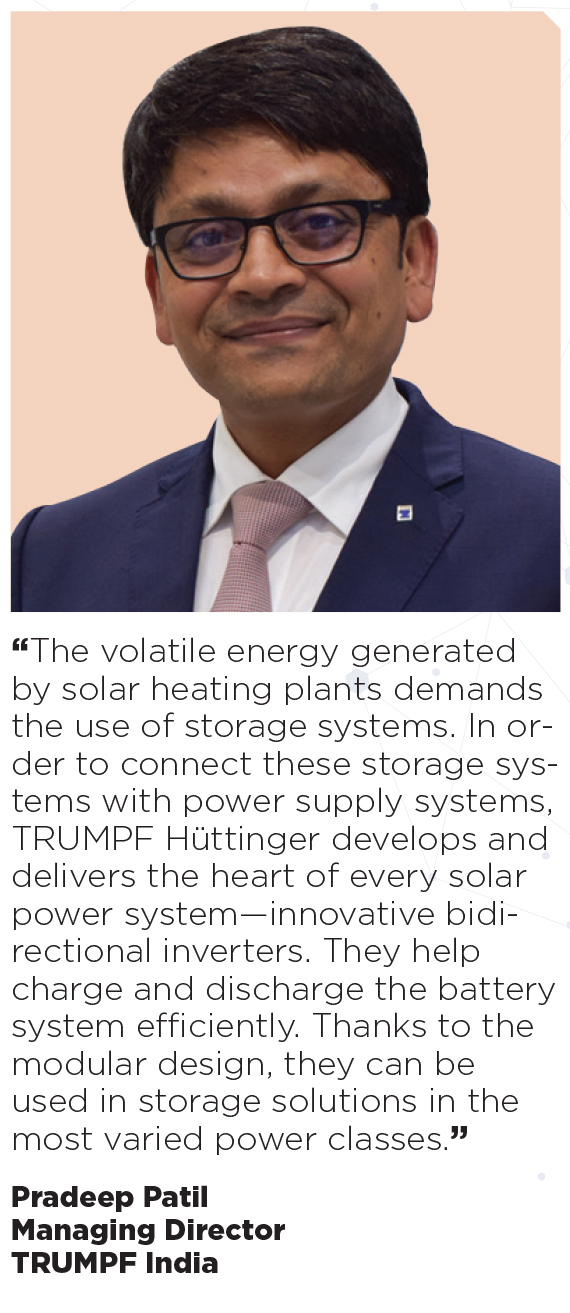
Solar energy is indispensable for the future but to ensure that photovoltaic systems are able to compete with conventional fossil fuels, production costs of PV modules must be reduced and the efficiency of solar cells increased.
Prasanth Sakhamuri, Director, ASM-HHV Engineering, a joint venture between Hind High Vacuum company and ASM Technologies that supplies key equipment required for the manufacture of solar cells, says, “Lasers play a significant role in various aspects of solar cell production, aiding in efficiency enhancement, precision manufacturing, and quality control. They are used extensively in cell manufacturing and module manufacturing. In cell manufacturing, they are used for dicing, patterning, texturization, contact generation, and quality control to name a few. The uses are increasing rapidly as the efficiencies are being pushed to the limit with hybrid manufacturing techniques.”
“Lasers offer precision, flexibility, and the ability to work at small scales, making them very useful tools in the production of solar cells,” he adds.
Mohammed Hidayath, Director, Sales, TRUMPF India, says, “TRUMPF offers customized solutions for this industry of the future and is opening up new opportunities for solar cell manufacturers and system constructors. TRUMPF lasers structure and interconnect the cells on the solar module and ensure through targeted de-coating that the modules have the necessary insulation resistance. TRUMPF Hüttinger is an industry leader in providing stable and precise process power supplies for coating solar cells. The vertical-cavity surface-emitting laser (VCSEL) heating systems from TRUMPF Photonic Components also open up advantages in solar cell production. For example, by removing energy barriers with targeted burning in of the contacts on the solar cell as well as with regeneration processes to reduce defects by intensive irradiation of the cell, thus increasing efficiency.”
Energy conversion
To protect thin-film solar modules from external influences, short and ultrashort pulse lasers remove the layer system at the edge of solar cells to a width of around a centimeter, so that it can be covered with film lamination. Lasers also impress during selective ablation of passivating layers on crystalline solar cells and when performing accurate drilling tasks in silicon. Lasers improve conversion efficiency and ensure a high-performance level.
|
Governments and companies around the world are investing in Photovoltaic technology in a big way to mitigate the negative effects of climate change. Once installed, its operation does not generate any pollution or any greenhouse gas emissions. |
Structuring silicon solar cells for increased efficiency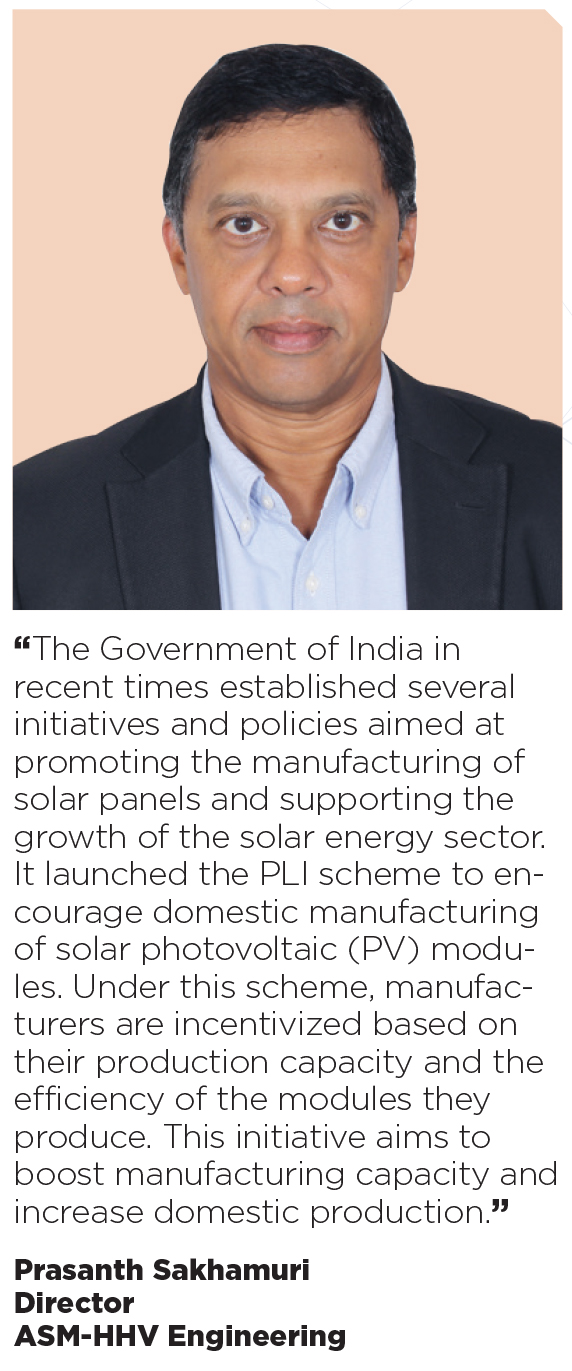
To exploit the energy potential of solar radiation, anti-reflection layers on silicon solar cells are used to reduce reflection and increase absorption on solar cells.
Professor Ramesh Babu says, “In modern organic thin film solar cells, laser micro-texturing of surface enhances the absorption of solar radiation and thin anti-reflection layer reduces the reflection loss, both contributing to increased efficiency of solar cells. Such layers are created by means of ultra-short pulsed lasers precisely and selectively removing the material from thin organic layers.”
Energy storage
The volatile energy generated by solar heating plants demands the use of storage systems. Pradeep Patil, Managing Director, TRUMPF India, says, “In order to connect these storage systems with power supply systems, TRUMPF Hüttinger develops and delivers the heart of every solar power system – innovative bidirectional inverters. They help charge and discharge the battery system efficiently. Thanks to the modular design, they can be used in storage solutions in the most varied power classes. In addition, they can be easily integrated in existing battery storage systems and can be combined with PV plants to create a future-oriented system. TRUMPF lasers are also used for welding electrical contacts. The locally limited, low heat input ensures high-precision distortion-free seams.”
Coating
In the production of silicon wafers and thin-film solar cells, the quality of the layers applied plays a crucial role. Layers with thicknesses fewer than one hundred nanometers are extremely sensitive and can easily degrade or lose their functionality. The reasons for this can be particle debris or delamination of irradiated layers, thermal damage of neighboring areas and other layers, as well as the generation of bulges in the outer areas of the ablation. The better the application of layers, the greater the ultimate module efficiency.
Patil says, “TRUMPF Hüttinger’s high-tech generators significantly influence the quality of the layers as they precisely control the energy input in the coating processes of the Solar industry. Renowned system constructors rely on the precise, stable process power supplies from the market leader for solar generators.”
|
With an average of about 300 clear and sunny days in a year in India, the calculated solar energy incidence on India’s land area is about 5,000 trillion kilowatt-hours (kWh) per year, which exceeds the possible energy output of all of the fossil fuel energy reserves in the country. |
Plasma coating - Creating the thinnest layers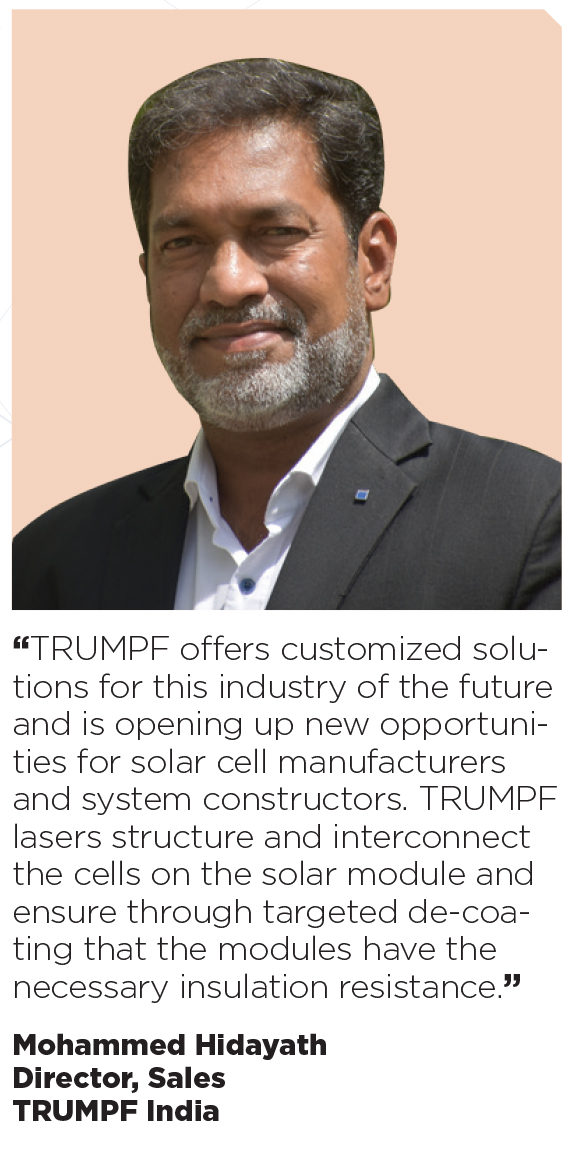
An essential process step during production of crystalline silicon solar cells is their coating with an antireflective and passivation layer. Amorphous hydrogenated silicon nitride (SiN) layers, deposited under vacuum by PECVD (Plasma Enhanced Chemical Vapor Deposition), have been demonstrated to be—besides good antireflection layers—excellent means for surface and bulk passivation on solar cells.
Hidayath says, “Modern coatings are predominantly applied in vacuum processes, either using physical vapor deposition (PVD) or chemical vapor deposition (CVD). The coating requires excitation of a suitable starting material. This can be done by thermal heating, e.g. evaporation. However, a variety of applications require electrical gas discharge or plasma for excitation. To generate these requires appropriate power supplies. The most important plasma coating processes are plasma-enhanced chemical vapor deposition (PECVD) and magnetron sputtering. A challenging variant of the latter is reactive sputtering to produce dielectric insulating protective layers. The high power impulse sputtering (HiPIMS) process also opens up new application options.”
India’s sunrise industry
With an average of about 300 clear and sunny days in a year in India, the calculated solar energy incidence on India’s land area is about 5,000 trillion kilowatt-hours (kWh) per year. The solar energy available in India in a single year exceeds the possible energy output of all of the fossil fuel energy reserves in the country.
Realizing this enormous potential, India is issuing 40 gigawatts (GW) tenders for solar and hybrid projects for the current fiscal. India has also established nearly 42 solar parks to make land available to the promoters of solar plants and the International Solar Alliance (ISA), proposed by India as a founder member. India has also put forward the concept of ‘One Sun One World One Grid’ and ‘World Solar Bank’ to harness abundant solar power on a global scale.
Supportive policies by the Indian Government are propelling PV manufacturing in India. According to a recent report by the Institute for Energy Economics and Financial Analysis (IEEFA) and JMK Research, India’s solar PV module capacity is set to reach 110 GW by 2026. At that point, India will attain self-sufficiency and be able to target the export market aggressively. The Government also promoted local manufacturing of PV modules through its production-linked incentive (PLI) scheme, with a total outlay of approximately US$3.2 billion over two tranches.
|
The PLI scheme will likely play a vital role in the coming years to drive the growth of India’s entire PV manufacturing ecosystem. Apart from attaining a module manufacturing capacity of 110 GW by 2026, India is also expected to have a significant presence in all aspects of PV manufacturing. |
Sakhamuri says, “What we would like to see is the Government’s initiative to institutionalize the technology in the country. Currently, all the manufacturing technology is imported either in the form of process or equipment. It would be best if the equipment and the process is developed in India either in the form of joint ventures with the companies with the technology and Indian manufacturing companies or a definitive indigenization program being offered by the turnkey supplier.”
The results of the policy measures by the Indian Government are already visible. For example, the capacity for PV cells and modules in India has more than doubled to reach 6.6 GW of cells and 38 GW of modules in 2023, even though they operate at only 50-60 percent capacity.
Sakhamuri adds, “The Government of India in recent times established several initiatives and policies aimed at promoting the manufacturing of solar panels and supporting the growth of the solar energy sector. It launched the PLI scheme to encourage domestic manufacturing of solar photovoltaic (PV) modules. Under this scheme, manufacturers are incentivized based on their production capacity and the efficiency of the modules they produce. This initiative aims to boost manufacturing capacity and increase domestic production.”
“The Government provides various anti-dumping duty protection and support to protect and enhance domestic manufacturing. These exemptions are intended to make the domestic players cost competitive against any possible dumping from China,” he further adds.
The PLI scheme will likely play a vital role in the coming years to drive the growth of India’s entire PV manufacturing ecosystem. Apart from attaining a module manufacturing capacity of 110 GW by 2026, India is also expected to have a significant presence in all aspects of PV manufacturing, including cells, ingots/wafers, and polysilicon.
The sun seems to be shining bright on the future of India’s Solar PV Manufacturing sector. With continued Governmental support, the Photovoltaics industry in India has the opportunity to become a key cog in the world’s future energy supply chain.
 |
Reji Varghese MD RV Forms & Gears fngreji@gmail.com |




 Facebook
Facebook.png) Twitter
Twitter Linkedin
Linkedin Subscribe
Subscribe